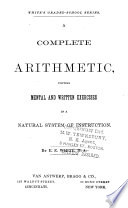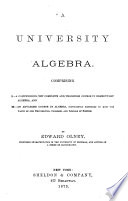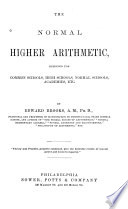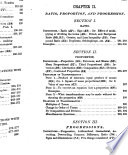 | Emerson Elbridge White - Arithmetic - 1870 - 350 pages
...greatest common divisor. 4. Tlie divisor of a number is a divisor of any number of times that number. 5. A common, divisor of two numbers is a divisor of their sum, or of their difference. 6. Any common divisor of eitlier of two numbers and their difference is a common... | |
 | Benjamin Greenleaf - Arithmetic - 1871 - 350 pages
...divisor of the number itself. Thus 3, a divisor of 9, a factor of 45, is a divisor of 45 itself. 121, A common divisor of two numbers is a divisor of their sum and of their difference. Thus 4, a common divisor of 16 and 12, is a divisor of their sum, 28, and of their... | |
 | Edward Olney - Geometry - 1872 - 562 pages
...finding the greatest common divisor of two or more numbers, it may be best first to prove that " A divisor of two numbers is a divisor of their sum, and also of their difference." This theorem, when proved for such a purpose, is culled a Lemma. The term Lemma is not much used, and... | |
 | Edward Olney - Geometry - 1872 - 472 pages
...finding the greatest common divisor of two or more numbers, it may be best first to prove that " A divisor of two numbers is a divisor of their sum, and also of their difference." This theorem, when proved for such a purpose, is called a Lemma. The term Lemma is not much used, and... | |
 | Edward Olney - Algebra - 1873 - 354 pages
...product of two such factors would be of a higher (or different) degree from the given polynomial. 2d. It cannot have a factor of the nth degree with reference...n, going into m, p times, and into n, q times. Then (те ± n) -f- a = p ± q. Q. в. D. 129. Prob. — Toßndthe П. С. D. of two polynomials without... | |
 | Joseph Ray - 1856 - 400 pages
...divisor of a, number is a divisor of any multiple of that number. As shown in Art. 89, Principle 1st. 2. A common divisor of two numbers is a divisor of their SUM. As shown, Art. 89, Principle 2d. 3. A common divisor of two numbers is a divisor of their DIFFERENCE.... | |
 | Edward Olney - Arithmetic - 1876 - 322 pages
...contained in 26 twice as many tunes, in 36 3 times as many times, etc. 170. PROP. 2.—A divisor of any two numbers is a divisor of their sum and also of their difference. This also is self-evident. Thus if a is contained in m 5 times, and in n 3 times, it is evident that... | |
 | Edward Brooks - Arithmetic - 1877 - 250 pages
...product of all the common prime factors of two or more numbers is their greatest common divisor. 3. A common divisor of two numbers is a divisor of their sum and also of their difference. DEM. — Take any two numbers, as 12 and 20, of which 4 is a common divisor. Now, 12 equals three times... | |
 | Edward Brooks - Arithmetic - 1877 - 528 pages
...The product of all the common prime factors of two or more numbers is their greatest common divisor. 4. A common divisor of two numbers is a divisor of their sum and also of their difference. DEMONSTRATION. — Take any two numbers, as 18 and 30, of which 6 is a common divisor. Now 18 equals... | |
 | Edward Olney - Algebra - 1877 - 466 pages
...finding the greatest common divisor of two or more numbers, it may be best first to prove that " A divisor of two numbers is a divisor of their sum, and also of their difference." This theorem, when proved for such a purpose, is called a Lemma. The term Lemma is not much used, and... | |
| |